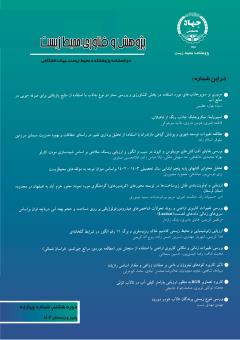ارزیابی ژئوشیمیایی و محیط زیستی کادمیم خاک ریزوسفری و برگ 11 رقم انگور در شرایط گلخانهای
محورهای موضوعی : خاکشناسی
هدا کریمی
1
![]() ,
شهریار مهدوی
2
*
,
شهریار مهدوی
2
*
![]() ,
نسرین حسن زاده
3
,
نسرین حسن زاده
3
![]() ,
روح اله کریمی
4
,
روح اله کریمی
4
![]()
1 - دانشجوی دکتری، گروه علوم محیطی، پژوهشکده انگور و کشمش، دانشگاه ملایر، ملایر، ایران
2 - دانشیار، گروه علوم خاک، دانشكدة کشاورزی، دانشگاه ملایر، ملایر، ایران
3 - استادیار، گروه محیط زیست، دانشکده محیط زیست و منابع طبیعی، دانشگاه ملایر، ملایر، ایران
4 - دانشیار، گروه مهندسی باغبانی و فضای سبز، دانشکده کشاورزی، دانشگاه ملایر، ملایر، ایران
کلید واژه: آلودگی خاک, شاخصهای ژئوشیمیایی, کادمیم, ارقام انگور,
چکیده مقاله :
كادميوم فلزی سمي است كه با افزايش آلودگيهاي محیط زیستی، ورود آن به خاک و زنجيره غذايي بهطور معنيداري افزايش یافته است. در اين تحقيق 11 رقم انگور (Vitis vinifera L.) در گلخانه تحقیقاتی دانشگاه ملایر در مواجهه با سه سطح كادميوم )صفر، 50 و 100 ميليگرم بركيلوگرم( به صورت ازمایش فاکتوریل بر پایه طرح کاملاً تصادفی مورد مطالعه قرار گرفت. پس از اعمال تیمارهای مختلف کادمیم در بازه زمانی حدود 4 ماه، نمونه¬های برگ و خاک ریزوسفری ارقام مختلف انگور جمعآوری و غلظت کادمیم و روی بهوسیله دستگاه جذب اتمی اندازه گیری شد. براساس نتایج اختلافهای معنیداری بین ارقام انگور از لحاظ محتوای کادمیم و روی برگ و خاک ریزوسفری مشاهده شد. کمترین محتوای کادمیم برگ و بیشترین کادمیم خاک ریزوسفری مربوط به رقم بیدانه سفید بود. همچنین بیشتریم محتوای روی برگ مربوط به رقم ترکمن 4 و بیشترین مقدار روی ریزوسفری مربوط به رقم ریش¬بابا بود. شاخصهای ژئوشیمیایی شامل: Igeo و Ipoll، CF و BAC در خاک سطحی در مقایسه با استاندارد پوسته و شیل زمین مورد ارزیابی قرار گرفت. با توجه به نتایج به دست آمده از این پژوهش در بررسی شاخصهای خاک در ارقام مختلف انگور و بررسی تأثیر ارقام مختلف، در خاک بدون تنش کادمیم در تمامی ارقام، طبق شاخص Ipoll و Igeo (مولر) در پوسته زمین، در طبقهی غیرآلوده و طبق استاندارد شیل در زمین به میزان کمی آلوده در نظر گرفته شد. خاک ارقام تحت تنش 50 میلیگرم بر کیلوگرم، طبق شاخص Igeo در پوسته زمین، در طبقهی کمی آلوده و طبق شاخص Ipoll در طبقه کمی آلوده تا خیلی آلوده و این شاخصها طبق استاندارد شیل در زمین در طبقه شدیداً آلوده قرار گرفت. نتایج خاک ارقام تحت تنش 100 میلیگرم بر کیلوگرم، طبق شاخص Igeo و Ipoll در پوسته زمین، در طبقه خیلی آلوده و با استاندارد شیل در زمین در طبقه شدیداً آلوده قرار گرفت. نتایج این شاخصها برای روی نشان داد در طبقه غیرآلوده قرار گرفتند.
Cadmium is a toxic metal that has significantly increased its entry into the soil and food chain with the rise of environmental pollution. In this study, 11 grapevine cultivars (Vitis vinifera L.) were exposed to three levels of cadmium (0, 50, and 100 milligrams per kilogram) in a factorial experimental design based on a completely randomized design in the research greenhouse of Malayer University. After applying the different cadmium treatments over a period of approximately 4 months, leaf and rhizosphere soil samples of different grapevine cultivars were collected, and the concentrations of cadmium and zinc were measured using an atomic absorption spectrometer. Significant differences were observed among grapevine cultivars in terms of cadmium and zinc content in leaves and rhizosphere soil. The cultivar "Bidaneh Sefid" had the lowest cadmium content in leaves, while the highest cadmium content in rhizosphere soil was observed in the cultivar "Rish Baba." Moreover, the cultivar "Turkmen 4" had the highest zinc content in leaves, and the cultivar "Rish Baba" had the highest zinc content in rhizosphere soil. Geochemical indices including Igeo, Ipoll, CF, and BAC were evaluated in the surface soil compared to the standard shell and earthworm. Based on the results of this study, in the examination of soil indices in different grapevine cultivars and the impact of different cultivars, according to the Ipoll and Igeo (Müller) indices in the shell, in non-stressed soil without cadmium, it was considered slightly contaminated, and according to the standard shell in the earthworm, it was considered quantitatively contaminated. According to the Igeo index in the shell, in soil under 50 milligrams per kilogram of cadmium stress, it was considered slightly contaminated, and according to the Ipoll index, it was considered slightly to moderately contaminated, and according to the standard shell in the earthworm, it was considered heavily contaminated. According to the Igeo and Ipoll indices in the shell, the results of soil under 100 milligrams per kilogram of cadmium stress, were considered heavily contaminated, and according to the standard shell in the earthworm, it was considered severely contaminated. The results of these indices indicated that zinc was in the non-contaminated category.
Abrahim, G. M. S. and Parker, R. J. 2008. Assessment of heavy metal enrichment factors and the degree ofcontamination in marine sediments from Tamaki Estuary, Auckland, New Zealand, Environ Monit Assess, 136:227–238
Alloway, B. J. (2013). Sources of heavy metals and metalloids in soils. Heavy metals in soils: trace metals and metalloids in soils and their bioavailability, 11-50
. Barbour, MT., Gerritsen, J., Snyder, BD., Stribling, JB, 1999. Rapid bioassessment protocols for use in sreams and river: Pryphyton, Benthic Macroinvertebrates and fish. 2nd edition, Vol. pp. 841-B-99-002. USEPA, Washington D.C. 408p
. Bermudez, G.M., Jasan, R., Plá, R., and Pignata, M.L. 2012. Heavy metals and trace elements in atmospheric fall-out: their relationship with topsoil and wheat element composition. Journal of Hazardous Materials, 213: 447-456
. Bhuiyan, M. A. H., L. Parvez, M. A. Islam, S. B. Dampare and S. Suzukia. 2010. Heavy metal pollution of coal mine-affected agricultural soils in the northern part of Bangladesh. J. Hazard. Mater. 173: 384-392
.

